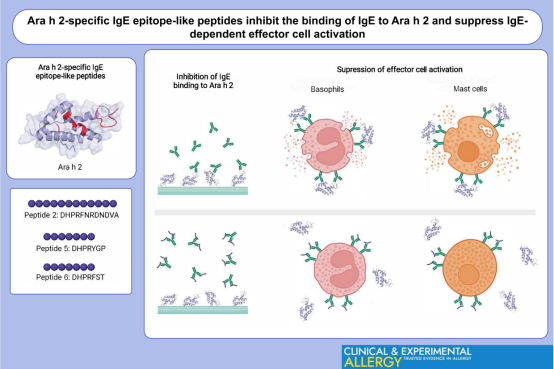Clin Exp Allergy:Ara h 2特异性IgE表位样肽抑制IgE与Ara h 2的结合并抑制依赖IgE效应细胞活化
发布日期:2023-06-22
——浙大迪迅 译
背景:临床和实验分析表明,过敏原IgE抗体表位-副表位的相互交联是导致效应细胞活化和lgE介导的食物过敏的主要初始步骤。本研究的目的是初步研究和评估阿糖胞苷H2特异性IgE表位样肽,它可以结合过敏原特异性IgE副表位和抑制效应细胞活化。方法:该研究进行了肽的生物筛选、IgE结合、选择和定位。生产了用于所有功能实验的合成肽。对LAD2人肥大细胞系进行 ImmunoCAP抑制、嗜碱性粒细胞和肥大细胞活化试验。
结果:我们鉴定并筛选了三种线性肽(DHPRFnRDDVA、DHPRYGP和DHPRFST),免疫印迹分析显示它们能与花生过敏个体的lgE抗体结合。这些肽序列与与Ara h 2的螺旋2和螺旋3之间的环状结构序列相比对,构象图显示这些肽与Ara h 2的螺旋2和螺旋6的表面相匹配,而与其他花生过敏原不匹配。在ImmunoCAP抑制实验中,这些多肽显著抑制IgE与Ara h 2的结合(p< 0.001)。在嗜碱性粒细胞和肥大细胞活化实验中,这些多肽能显著抑制Ara h 2诱导的效应细胞活化(p< 0.05),增加了Ara h 2半数最大有效浓度(p< 0.05)。这些肽链与特异性IgE的结合不会引起嗜碱性粒细胞或肥大细胞的活化。
结论:这些研究表明,上述肽链可降低Ara h 2的致敏活性并抑制依赖lgE的嗜碱性粒细胞和肥大细胞的激活。这些观察结果可为基于表位-副表位阻断的食物过敏治疗提供一种新的治疗策略。

原始出处
Clin Exp Allergy
[IF:5.131]
Title:Arah2-specific IgE epitope-like peptides inhibit the binding of IgE to Arah2 and suppress lgE-dependent effector cell activationDOI: 10.1111/cea.14314
Abstract:
Background: Clinical and experimental analyses indicate a pathognomonic role for allergen IgE crosslinking through epitope–paratope interactions as a major initial step in the cascade leading to effector cell activation and clinical manifestations of lgE-mediated food allergies. We aimed to undertake the initial development and assessment of Ara h 2-specific IgE epitope-like peptides that can bind to allergen specific IgE paratopes and suppress effector cell activation.
Methods: We performed biopanning, screening, IgE binding, selection and mapping of peptides. We generated synthetic peptides for use in all functional experiments. ImmunoCAP inhibition, basophil and mast cell activation tests, with LAD2 cells, a human mast cell line were performed. Twenty-six children or young adults who had peanut allergy were studied.
Results: We identified and selected three linear peptides (DHPRFNRDNDVA, DHPRYGP and DHPRFST), and immunoblot analyses revealed binding to lgE from peanut-allergic individuals. The peptide sequences were aligned to the disordered region corresponding to the loop between helices 2 and 3 of Ara h 2, and conformational mapping showed that the peptides match the surface of Ara h 2 and h 6 but not other peanut allergens. In ImmunoCAP inhibition experiments, the peptides significantly inhibit the binding of IgE to Ara h 2 (p< 0.001). In basophil and mast cell activation tests, the peptides significantly suppressed Ara h 2-induced effector cell activation (p<0 .05) and increased the half-maximal Ara h 2 effective concentration (p<0 .05). Binding of the peptides to specific IgEs did not induce activation of basophils or mast cells.
Conclusions: These studies show that the indicated peptides reduce the allergenic activity of Ara h 2 and suppress lgE-dependent basophil and mast cell activation. These observations may suggest a novel therapeutic strategy for food allergy based on epitope–paratop blocking.
First Author: Peter Korošec
Corresponding author: Peter Korošec
Correspondence: Peter Korošec, University Clinic of Respiratory and Allergic Diseases Golnik, Golnik 36, 4204 Golnik, Slovenia.
Email: peter.korosec@klinika-golnik.si
开云电子(中国)官方网站 | 华亿首页(中国)网页版 | 开云网页版 | 天博手机网页(中国)有限公司 | 千亿体育线上平台中国有限公司 | 米兰手机在线登入 | 米乐官方网页版 | 华亿网页版 | 三亿体育首页(中国)网站首页 |
 华亿体育(中国)游戏平台
华亿体育(中国)游戏平台

